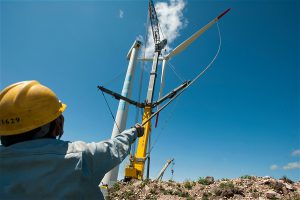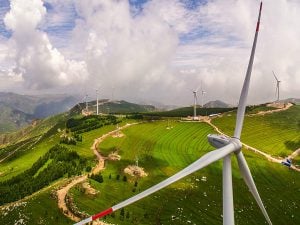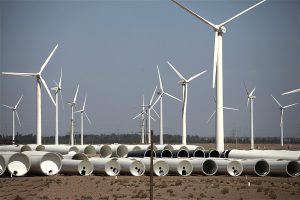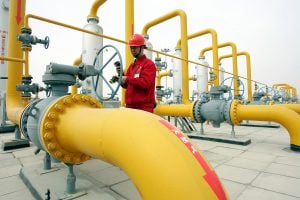Presenting his 2017 government work report to the National People’s Congress in March, Premier Li Keqiang stressed the importance of making China’s skies blue again by integrating renewables more effectively into the power grid.
Despite its enormous investment in renewable energy and owning the most installed capacity globally, China is yet to reap the full benefits from its renewable sectors. Record high curtailment of renewable energy prevents these resources from effectively contributing to clearer skies. Addressing the problem won’t be easy but would be a major boon for air quality.
Record energy losses
Curtailment occurs when the grid can’t handle all the resources feeding into it. According to China’s National Energy Agency (NEA), the national average wind curtailment rate in 2015 was 15%. Using the same method of calculation, it rose to 17% for 2016.
The 11 provinces with three-quarters of the country’s installed wind power capacity curtailed 49.7 terawatt hours (TWh) of wind power last year, enough to power Beijing for six months.
The average photovoltaic (PV) curtailment rate in northwestern China in 2016 was 20% – a total of 7 TWh of PV curtailed. Together, this represents 56.7 TWh of clean power not delivered to the grid. For comparison, that’s about one sixth of the UK’s entire electricity generation.
Energy production and curtailment of wind and solar in 2016

Solar energy production and curtailment data is only shown for provinces in the northwest. Source: NEA
But overall rates do not tell the whole story because curtailment in some provinces is well above average.
Losses are worst in the bright and windy northwest. Gansu province curtailed 40% of its wind and solar energy in 2016, and Xinjiang had to dump 37%. Gansu, Xinjiang and Inner Mongolia have China’s greatest installed capacity of wind and solar and so a large share of energy production.
Installed wind and solar capacity and curtailment rates in 2016

To put China’s levels of curtailment in perspective, it’s worth contrasting them with the situation in the US and Europe where rates are typically between 0-5%, even in countries that have a higher proportion of renewables in the overall energy mix. Some curtailment can be economically justified to ensure the stability of supplies to the grid and enable high shares of renewables.
Tackling the problem
The government recognises that curtailment is an obstacle to a greener, more sustainable energy system.
A document published in 2015 set the direction for reforms in the power sector, highlighting measures that can reduce energy waste by improving dispatch to the grid and increasing cross-provincial energy trading.
A subsequent set of policies issued last year aimed to further reduce curtailment by prioritising renewable energy in dispatch, and compensating generators for curtailment. These policies have yet to be fleshed out and implemented though.
When the NEA published the 13th Five-Year Plan for the power sector in November 2016, it said it wanted to reduce curtailment to a reasonable level within five percent, but provided no details of specific short-term measures.
Benefits for air quality
Tackling the curtailment problem is crucial not just for the efficient functioning of the electricity system but because renewables can displace dirtier forms of energy such as coal. Air pollution is a serious problem in all of China’s provinces, including ones with high curtailment rates.
In 2015, no province met the World Health Organization’s air pollution guidelines for PM2.5 concentrations, and most fell short of China’s less stringent national guidelines.
So ensuring the full utilisation of renewables already installed could yield significant air quality benefits.
A rough calculation of renewable energy lost in Gansu, Xinjiang, and Inner Mongolia – the three provinces curtailing most renewables – suggests that China needlessly mined, transported and burned 13.2 million tonnes of coal in 2016.
Getting curtailment down to five percent or below would cut tonnes of pollutants caused by coal burning. The Health Effects Institute find that coal power contributed to 87,000 premature deaths in China in 2013 so even a small reduction in total emitted pollutants could save hundreds of lives every year, using technology that is already installed.
Emissions reductions are estimated by applying provincial power production to region-specific emission factors. These take account of extensive efforts made during the 10th and 11th Five-Year Plan periods to reduce particulate and sulphur dioxide (SO2) emissions from power plants, but not the control measures for nitrogen oxides (NOX) such as smog-inducing nitric oxide and nitrogen dioxide introduced in the 12th Five-Year Plan (2011-2015).
Tonnes of PM2.5, NOx and SO2 emissions avoided each year if curtailment was 5%

Getting to a 5% curtailment rate in Gansu would mean saving emissions corresponding to 18% of the emissions from coal power plants in the province in 2016.
For Xinjiang, it would represent a 9% saving, and in Inner Mongolia 3%. The avoided NOX emissions combined correspond to taking about 50 million cars off the streets.
Avoided emissions if renewables curtailment was 5%, expressed as a share of coal power plant emissions

Renewables will play a more prominent role in Chinese energy production, making the ability to integrate this production into the grid increasingly important.
In just a few years, China plans to double its share of wind power to six percent of total generation capacity. Wind and solar combined will make up eight percent of total generation capacity in 2020.
But the impact of renewable energy on air quality will depend on policymakers’ plans and actions to reach the 2020 target of five percent curtailment.
China has made progress improving its air quality, with pollutant concentrations in cities on a downward trend.
Nonetheless, at the current rate of improvement, it will take 23 years for Lanzhou, the capital of Gansu province, to meet the WHO’s standards for PM2.5 concentration. Xinjiang’s capital city Urumqi would need to wait 30 years, and the Inner Mongolian capital, Hohhot, 12 years.
Reducing renewable energy curtailment would help accelerate progress. Making sure that variable renewables such as wind and solar are efficiently integrated into the grid is a crucial step if China is to realise its air pollution targets and make the skies blue again.
A different version of this blog can be found at the Regulatory Assistance Project






![Arctic ice continues to melt, we must approach the challenge with some hope [image by: NASA/Kathryn Hansen]](https://dialogue.earth/content/uploads/2017/04/Arctic-ice-NASA-300x200.jpg)

